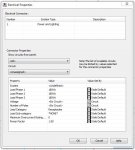RJK42
Member
- Location
- Binghamton, NY, USA
Hello!!
I'm new to the forums and new to the industry. I was recently picked up by a contractor as a drafter to create new drawings and continue with as-builts. I use AutoCAD MEP to drawing our prints and I am utilizing the tools to implement the built in panel schedules. The scheduling part is nice but I still have to input data for the phase loads. I have been looking through NEC, especially section 220 to see if there are any references to calculations needed for inputting values in the schedules.
Is there a good reference regarding formulas needed in order to calculate these values?? i.e., phase loads, demand factors....
I'm not seeing anything to refer to unless I'm over looking.
Thanks in advance!!
I'm new to the forums and new to the industry. I was recently picked up by a contractor as a drafter to create new drawings and continue with as-builts. I use AutoCAD MEP to drawing our prints and I am utilizing the tools to implement the built in panel schedules. The scheduling part is nice but I still have to input data for the phase loads. I have been looking through NEC, especially section 220 to see if there are any references to calculations needed for inputting values in the schedules.
Is there a good reference regarding formulas needed in order to calculate these values?? i.e., phase loads, demand factors....
I'm not seeing anything to refer to unless I'm over looking.
Thanks in advance!!

